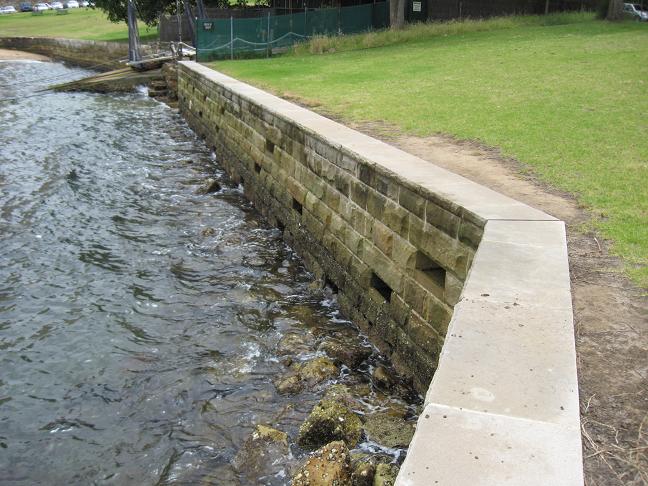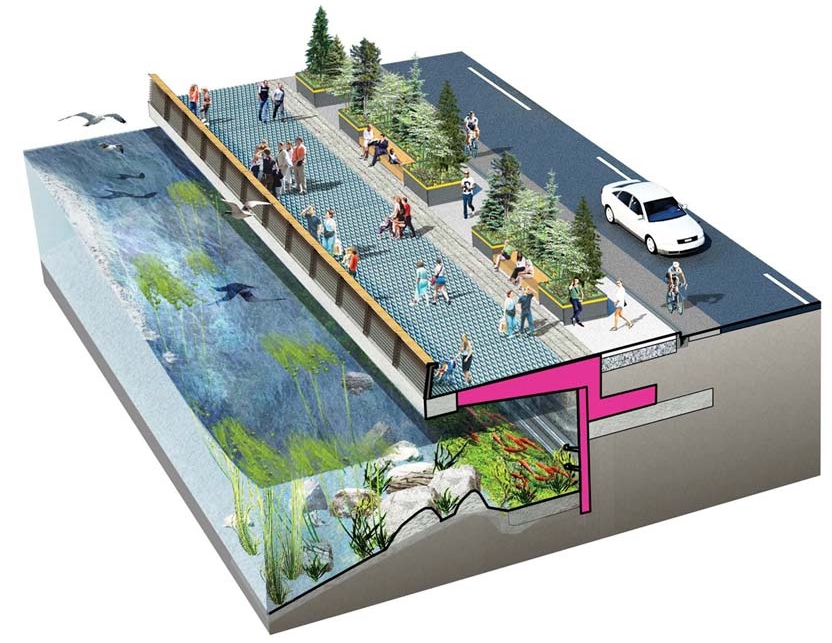If you’re looking for similar projects, you’ve come to the right page!
Featuring Environmentally Friendly Projects from Australia and the USA
Australia made guidelines for designing environmentally friendly seawalls because traditional seawalls are not good habitats for marine life, due to the 4 “S” factors:
| Traditional Seawalls | Suggested Improvements | |
| Substrate (material) | concrete | natural material (rocks) |
| Surface (texture) | smooth | rough and irregular more complexity (e.g. crevices) |
| Size (depth and width) | shallow and short | deep and long (comparable to the habitat replaced) |
| Slope (angle) | steep vertical walls | gradually sloping shorelines |

This 150 m seawall at McMahons Point, in Sydney, Australia, cost around $2 million (Sydney Metropolitan Catchment Management Authority & Department of Environment and Climate Change NSW 2009).
The McMahons Point seawall now includes tide pools and boulders at its base to increase the surface area available to marine life. By adding complexity to the seawall, the University of Sydney found that organisms were making use of the seawall more than than they used to. Being a developed country, Australia can afford to put money into environmentally friendly projects, as can Canada and the USA.
Seattle, Washington is another city that can afford environmentally friendly projects, such as its iconic downtown waterfront in Elliott Bay. The wooden pilings that support the existing seawall are old and rotting, so the City of Seattle seized the opportunity to upgrade the entire 3 km downtown waterfront core, which includes the seawall. From storefronts to beaches and roadways to natural landscapes, it seems as though nothing has been missed in this environmentally conscious revamp of an iconic waterfront.

Artist rendition of the future Elliott Bay, Seattle seawall. The massive scale of this project comes with an equally massive price tag funded by taxpayers, which was at $420 million as of September 2014 (up from the initial $300 million when construction started). The City of Seattle maintains that the central section is scheduled to be completed in 2016 and that the entire project will be finished by 2020 (City of Seattle 2014).
As seen in the image above, the overhanging sidewalk will be composed of thousands of light penetrating surfaces so that sunlight will still be able to reach the water. The goal is to allow light to penetrate to the water, which will encourage salmon to use the lit, but covered (protected) area to travel along the shore. Salmon do not swim under the current piers as it is too dark for them. Passersby will see the entertaining sight of salmon while the salmon themselves have safe passage. The image also shows that there will be additional complexity in the form of a habitat ladder that provides shelves at varying depths for marine life.
